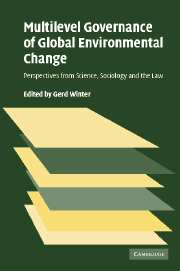 Multilevel Governance of Global Environmental Change
Multilevel Governance of Global Environmental Change Book contents
- Frontmatter
- PREFACE
- Contents
- List of figures
- List of tables
- Notes on contributors
- List of abbreviations
- 1 Introduction
- PART I Earth system analysis
- PART II Society and institutions of global; environmental change
- PART III Self-regulation of industry and the law
- PART IV The potential of the state
- PART V The potential of world regions
- PART VI Formation and implementation of international regimes
- 15 Multilateral environmental agreements and the compliance continuum
- 16 On clustering international environmental agreements
- 17 Institutions, knowledge, and change: findings from the quantitative study of environmental regimes
- PART VII Improving the instruments of global governance
- PART VIII Fundamental concepts of institutionalising common concern
- Index
15 - Multilateral environmental agreements and the compliance continuum
Published online by Cambridge University Press: 04 May 2010
- Frontmatter
- PREFACE
- Contents
- List of figures
- List of tables
- Notes on contributors
- List of abbreviations
- 1 Introduction
- PART I Earth system analysis
- PART II Society and institutions of global; environmental change
- PART III Self-regulation of industry and the law
- PART IV The potential of the state
- PART V The potential of world regions
- PART VI Formation and implementation of international regimes
- 15 Multilateral environmental agreements and the compliance continuum
- 16 On clustering international environmental agreements
- 17 Institutions, knowledge, and change: findings from the quantitative study of environmental regimes
- PART VII Improving the instruments of global governance
- PART VIII Fundamental concepts of institutionalising common concern
- Index
Summary
Introduction
The promotion of compliance with international environmental commitments is among the most challenging issues of global environmental governance. Compliance is an issue that straddles various arenas and disciplinary debates. Not only has the issue received much attention in both the practice and the theory of global governance, it is also a genuine ‘governance’ issue in that it demands engagement of international lawyers with the insights of international relations experts, and vice versa.
In the context of multilateral environmental agreements (MEAs), the topic of compliance has come to be synonymous with the design of non-compliance procedures and other strategies specifically geared to promoting compliance. Six MEA-based non-compliance procedures are in effect, several others are at various stages of negotiation. Indeed, the inclusion of a compliance regime appears to have become a routine agenda item for MEA negotiations. Often, the main question is not so much whether a compliance procedure should be developed but what its approach should be: should it be largely ‘soft’ and facilitative, or should it include ‘hard’, enforcement-oriented features? In this respect, the debates about the design of MEA-based compliance regimes have much overlap with the prominent theoretical debate about whether compliance is best promoted through managerial or enforcement-oriented approaches.
The rapid evolution of MEA-specific compliance procedures illustrates that the practice of international environmental law has come a long way in a relatively short period of time. A little over ten years ago, MEAs contained only limited compliance-related elements.
- Type
- Chapter
- Information
- Multilevel Governance of Global Environmental ChangePerspectives from Science, Sociology and the Law, pp. 387 - 408Publisher: Cambridge University PressPrint publication year: 2006
- 1
- Cited by


